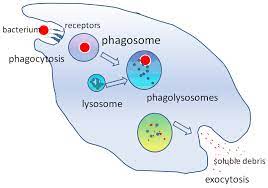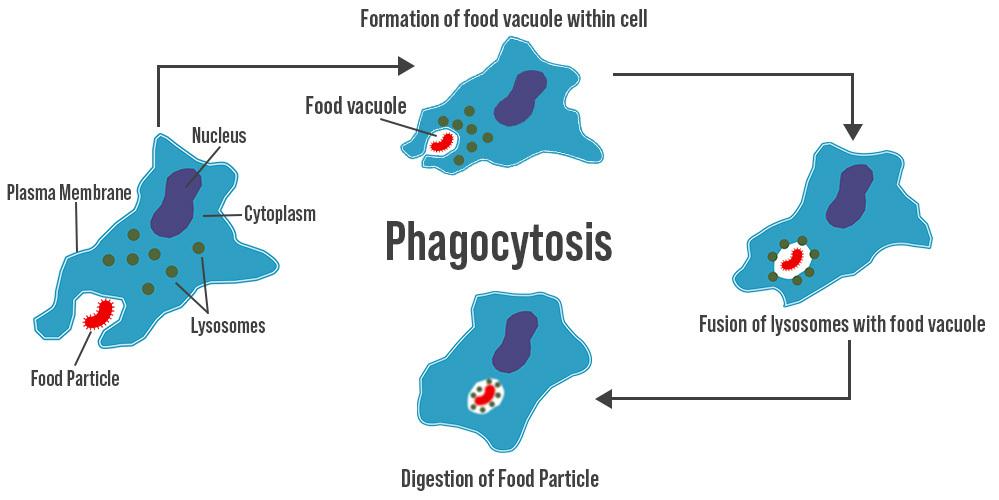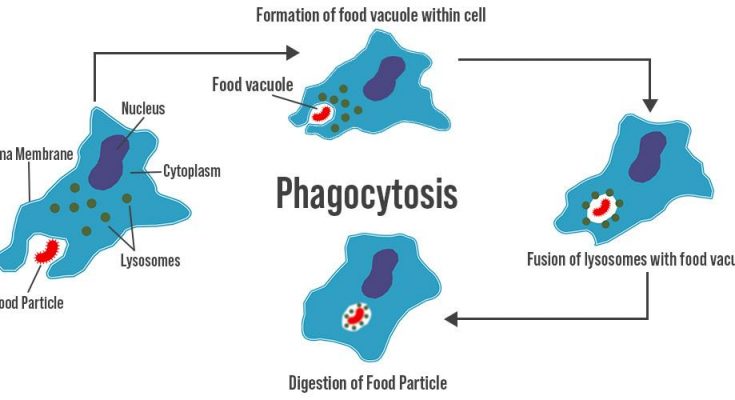Amoeba is a single-celled microorganism that acquires its food through a process termed as Phagocytosis.
Phagocytosis is the process that allows Amoeba to engulf and digest its food. Amoeba is shapeless and constantly changes its body structure which enables it to move and acquire food.
Phagocytosis is a specialized form of Endocytosis which involves the engulfment of large particles or microorganisms by a cell.
During phagocytosis Amoeba extends its pseudopodia (finger-like projections of its cell membrane) to surround the food particle and bring it into its cytoplasm. Once inside the food particle is enclosed in a membrane-bound vesicle called a phagosome. The phagosome fuses with lysosomes which contain digestive enzymes that break down the food particle into smaller molecules. These molecules are then transported to the cytoplasm of the cell and used for energy and growth.
In this article we will discuss how Amoeba acquires its food through Phagocytosis, the role of pseudopodia, factors that affect phagocytosis in Amoeba etc.
Table of Contents
How Amoeba Acquires its Food ?

- Amoeba acquires its food through a process termed phagocytosis which is a type of Endocytosis.
- Phagocytosis is the process by which cells engulf and digest large particles or microorganisms. In Amoeba phagocytosis is the primary method of nutrient acquisition.
- The process of phagocytosis begins with the recognition and binding of the food particle by the cell membrane.
- The membrane then extends around the particle forming a cup-shaped structure called a phagosome.
- The phagosome then moves into the cytoplasm of the cell where it fuses with lysosomes which are membrane-bound organelles that contain digestive enzymes.
- Once the phagosome fuses with the lysosome the food particle is digested by the lysosomal enzymes.
- The resulting nutrients such as amino acids and sugars are then transported to the cytoplasm of the cell where they are used for energy and growth.
Also Check – Nutrition in Amoeba
Also check – What is Holozoic Nutrition ?
Explanation of the process of Phagocytosis
Phagocytosis is a type of endocytosis, a process by which amoeba Engulf and digest large particles or microorganisms. In the case of phagocytosis the particles that are taken in are large solid particles such as bacteria or other microorganisms.
Step by step Process of phagocytosis is as follows –

Detection of food particles
- Amoebas detect food particles in their environment through chemotaxis which is the ability to move towards or away from specific chemical signals.
- Once a food particle is detected the amoeba extends its pseudopodia towards the particle.
Engulfment
- The pseudopodia of the amoeba surround the food particle and fuse together forming a sac-like structure called a phagosome around the food particle.
- The phagosome separates from the cell membrane and moves into the cytoplasm of the amoeba.
Digestion
- Lysosomes in the cytoplasm of the amoeba fuse with the phagosome releasing digestive enzymes into the phagosome.
- These enzymes break down the food particle into smaller molecules that can be absorbed and used for energy by the amoeba.
Absorption
- The smaller molecules produced by digestion are absorbed into the cytoplasm of the amoeba through the membrane of the phagosome.
- The absorbed molecules are used by the amoeba for energy and growth.
Excretion
- Waste materials produced by digestion are excreted from the amoeba through a process called exocytosis.
- The remains of the food particle are also excreted from the amoeba through exocytosis.
Also Check – Holozoic Nutrition Example
Also Check – Nutrition in Paramecium
The Role of Pseudopodia in Phagocytosis
- Pseudopodia are temporary extensions of the cell membrane that are used by Amoeba for movement and phagocytosis.
- Pseudopodia can take on various shapes and sizes depending on the species of Amoeba and the environmental conditions.
- The role of pseudopodia in phagocytosis is important because they enable Amoeba to engulf and digest food particles.
- Pseudopodia are used to surround the food particle and form the cup-shaped structure known as the phagosome.
- Pseudopodia then help move the phagosome towards the center of the cell where it fuses with lysosomes for digestion.
- Pseudopodia are also important in Amoeboid Movement by which Amoeba moves towards a food source or away from a harmful stimulus. Without pseudopodia Amoeba would not be able to move towards a food source or away from a harmful stimulus.
Factors that affect Phagocytosis in Amoeba
Phagocytosis is a complex process that is influenced by various factors. These factors can affect the efficiency and rate of Phagocytosis in Amoeba.
The following are some of the factors that affect phagocytosis in Amoeba –
- Temperature – Temperature is an important factor that affects the rate of phagocytosis in Amoeba. Optimal temperature for phagocytosis in Amoeba ranges between 20 to 25 degrees Celsius. At lower temperatures phagocytosis is slowed down due to the decreased metabolic rate of the cell and at higher temperatures the cell membrane becomes more fluid and unstable which leads to decreased efficiency of phagocytosis.
- PH – PH is another important factor that affects the rate of phagocytosis in Amoeba. Optimal pH for phagocytosis in Amoeba is slightly acidic ranging from pH 5.5 to pH 6.5.
- Availability of food- The availability of food is a critical factor that affects the rate of phagocytosis in Amoeba. In conditions where food is scarce, Amoeba may become more efficient in phagocytosis as the cell tries to maximize its chances of survival by acquiring as much food as possible. Conversely, when food is abundant, the rate of phagocytosis may decrease as the cell has less of a need to actively search for food.
Frequently asked questions on Amoeba Acquiring Food through the Process of Phagocytosis
What is Phagocytosis?
Phagocytosis is the process by which cells engulf and digest large particles or microorganisms.
How does Amoeba acquire its food?
Amoeba acquires its food through the process of phagocytosis.
What is the role of pseudopodia in phagocytosis?
Pseudopodia are used by Amoeba for movement and phagocytosis. They enable Amoeba to surround and engulf food particles and then move the phagosome towards the center of the cell where it fuses with lysosomes for digestion.
What are the steps of phagocytosis in Amoeba?
The steps of phagocytosis in Amoeba are – detection of food particles, engulfment, digestion, absorption and excretion.
What factors affect phagocytosis in Amoeba?
Some factors that affect phagocytosis in Amoeba include temperature, pH, concentration of food particles and the presence of inhibitors or stimulants.
What is chemotaxis?
Chemotaxis is the movement of an organism or cell towards or away from a chemical stimulus.
What are lysosomes and what is their role in phagocytosis?
Lysosomes are membrane-bound organelles containing enzymes that break down macromolecules. In phagocytosis, lysosomes fuse with the phagosome, releasing enzymes that digest the ingested material.
What are the smaller molecules produced by digestion used for?
The smaller molecules produced by digestion, such as amino acids, glucose and fatty acids, are used by the organism for energy production, building and repairing tissues and other metabolic processes.
How does excretion take place in amoeba?
Excretion in amoeba occurs by diffusion through the cell membrane. Waste products, such as carbon dioxide and ammonia, passively diffuse out of the cell.
What would happen if amoeba did not have pseudopodia?
Pseudopodia are extensions of the cell membrane that amoeba use for movement and engulfing food. If amoeba did not have pseudopodia, they would not be able to move or feed efficiently, which could lead to decreased survival and reproduction.


6 Comments on “How Amoeba Acquires its Food through the Process of Phagocytosis”